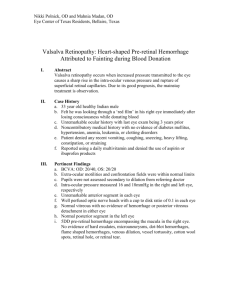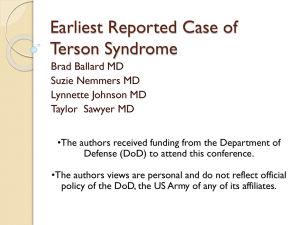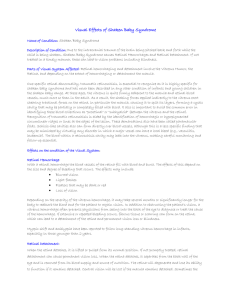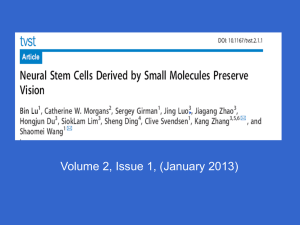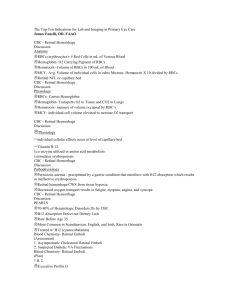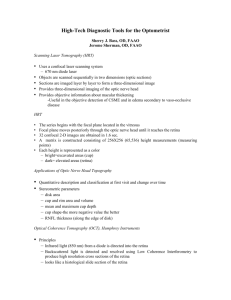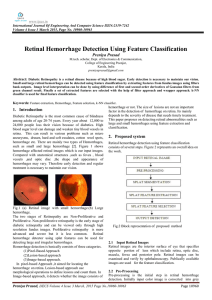Posterior Segment Fundamentals
advertisement
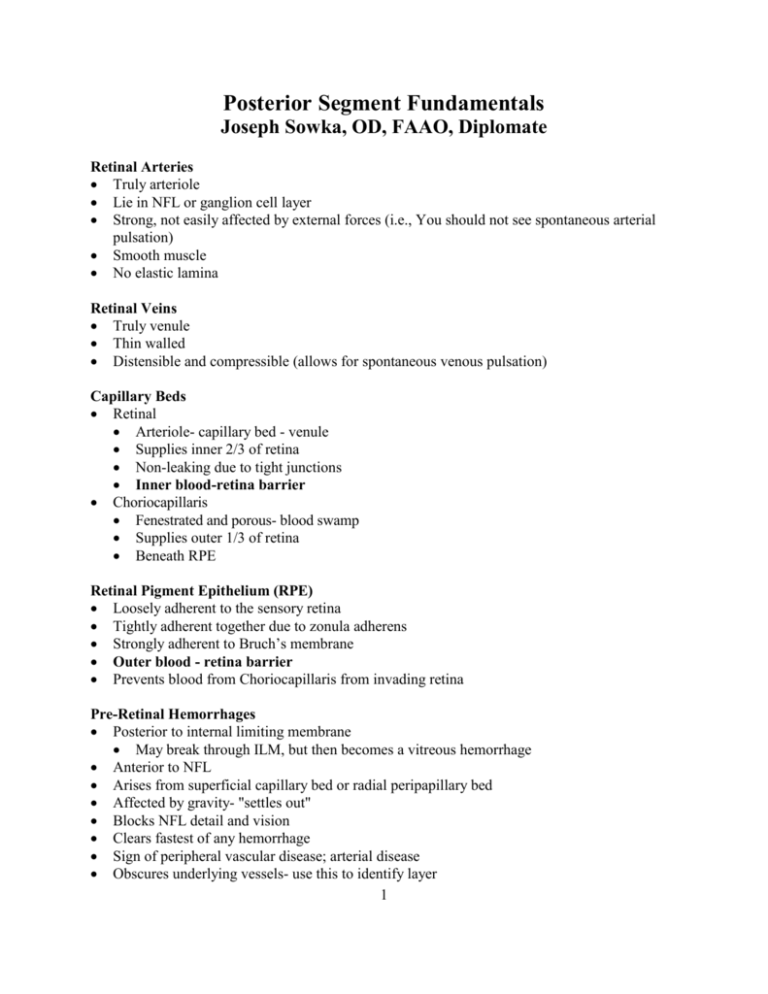
Posterior Segment Fundamentals Joseph Sowka, OD, FAAO, Diplomate Retinal Arteries Truly arteriole Lie in NFL or ganglion cell layer Strong, not easily affected by external forces (i.e., You should not see spontaneous arterial pulsation) Smooth muscle No elastic lamina Retinal Veins Truly venule Thin walled Distensible and compressible (allows for spontaneous venous pulsation) Capillary Beds Retinal Arteriole- capillary bed - venule Supplies inner 2/3 of retina Non-leaking due to tight junctions Inner blood-retina barrier Choriocapillaris Fenestrated and porous- blood swamp Supplies outer 1/3 of retina Beneath RPE Retinal Pigment Epithelium (RPE) Loosely adherent to the sensory retina Tightly adherent together due to zonula adherens Strongly adherent to Bruch’s membrane Outer blood - retina barrier Prevents blood from Choriocapillaris from invading retina Pre-Retinal Hemorrhages Posterior to internal limiting membrane May break through ILM, but then becomes a vitreous hemorrhage Anterior to NFL Arises from superficial capillary bed or radial peripapillary bed Affected by gravity- "settles out" Blocks NFL detail and vision Clears fastest of any hemorrhage Sign of peripheral vascular disease; arterial disease Obscures underlying vessels- use this to identify layer 1 Most superficial of any retinal hemorrhage Clinical Pearl: Pre-retinal hemorrhages are confluent and will block all underlying retinal detail. Flame Shaped Hemorrhages Post-arteriolar superficial capillary bed Peripapillary capillary bed (associate this with glaucoma when it radiates off of the disc) Follows contour of NFL Roth's spots- superficial hemorrhage with inner infarcted area- associated with anemia. Called NFL hemorrhage Short duration Occurs with optic nerve dysfunction, vascular occlusion, and arterial disease Clinical Pearl: Flame shaped (nerve fiber layer) hemorrhages are most associated with retinal vein occlusions and hypertensive retinopathy. Dot and Blot Hemorrhages Inner nuclear layer, outer plexiform layer, outer nuclear layer Prevenular deep capillary bed Signals venous congestive disease Resolves slower Blocks NaFl on FA Retina compresses and confines the blood to give the characteristic shape Dot vs. Blot hemorrhage: subjective- blot is slightly larger than dot. Clinical Pearl: Dot & blot hemorrhages are most associated with diabetic retinopathy and ocular ischemic syndrome (OIS). Clinical Pearl: Any healthy patient is allowed to have a single, isolated, blot hemorrhage without having to undergo an intensive medical evaluation. Subretinal and Sub-RPE Hemorrhages Secondary to choroidal neovascular membrane (CNVM) Breakthrough of deep hemorrhages Between RPE and sensory retina Sub-RPE (gray/green color) Clinical Pearl: Sub-retinal hemorrhages are identified by your ability to see distinct retinal vessels overlying the hemorrhaging area. If you can see the retinal vessels, then the hemorrhage must be beneath the retina. Hard exudates Lipid soup 2 Waxy yellow lesions at level of OPL Lipid laden macrophages Serum lipoproteins Circinate retinopathy Outer plexiform layer Very slow to resolve Cotton Wool Spots Historically were erroneously called "soft exudates" Focal retinal ischemia- infarcted retina Indicates hypoxia Arteriolar microinfarcts in NFL Blockage of terminal retinal arteriole Axoplasmic damning 6 week duration Mistaken for true exudates and medullated nerve fibers Diabetes is most common systemic association with CWS, followed by: Retinal venous obstruction Systemic arterial hypertension (diastolic greater than 110 mm hg) Collagen vascular disease (Systemic lupus erythematosus) Aids Clinical Pearl: When encountering cotton wool spots, many eye care physicians employ the ‘ostrich with its head in the sand’ approach in that they monitor the patient and when the CWS goes away in 6 weeks, they feel that everything is fine. This is negligence. Excluding diabetes, Brown and associates found significant, potentially serious underlying systemic disease in 95% of patients characterized by a predominance of CWS or a single CWS. A single CWS must have an intensive medical evaluation beginning with hypertension (diastolic must be greater than 110 mm hg) and diabetes. And don’t forget HIV/AIDS, Lupus, and leukemia. 3



